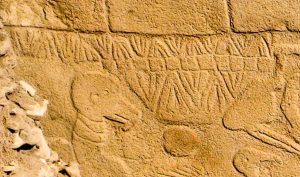
A new analysis of the carvings engraved into the ancient stones at Göbekli Tepe have revealed what may be the world’s oldest solar calendar, a system of timekeeping that, at over 12,000 years old, predates other ancient calendar systems by many thousands of years. And if that discovery isn’t sufficiently earth-shaking, this Paleolithic calendar appears to mark the impact of a comet that may have triggered the brief return of ice-age temperatures around the world.
Discovered by University of Edinburgh engineer Dr. Martin Sweatman, the calendar, located above Göbekli Tepe’s iconic vulture carving that adorns Enclosure D’s Pillar 43, appears as a series of V-shaped markings that appear to represent the individual days of the calendar in question: Sweatman’s research indicates that these markings count a solar year of 365 days, divided into 12 lunar months with an accompanying 11 extra days.
Sweatman says that the summer solstice is singled out as a separate, special day, represented by the V symbol that appears on the neck of the vulture, itself interpreted to be a representation of the modern-day constellation of Sagittarius, of which the Sun would have appeared in during the summer solstice 12,000 years ago (today that honor belongs to Gemini).
If these markings do represent a functioning calendar, they would represent the world’s oldest, predating the previous earliest-known examples by many thousands of years. This ancient calendar also appears to indicate that Göbekli Tepe’s builders were aware of the long-term wobble of the planet’s axis, a precession that causes the constellations to slowly shift their positions in the sky over the course of millennia.
Based on carvings from a nearby pillar that appear to depict the Taurid meteor storm, Sweatman also proposes that this early calendar commemorates the impact of the comet that is at the center of the Younger Dryas impact hypothesis (YDIH), wherein the high-altitude explosion caused by a comet entering the planet’s atmosphere 12,900 years ago. This event triggered a runaway melting event in the already-receding North American ice sheet and sparked massive fires across the continent, causing an abrupt change in the global climate that hastened the extinction of numerous species of megafauna, along with the disappearance of the peoples of North America’s Clovis culture.
Although not as immediately devastating as it was to the inhabitants of North America, the environmental upheaval it caused around the globe saw a dramatic cooling across Europe, Greenland and North America over a span of less than a decade, while the Southern Hemisphere saw a warming period as a result of the disruption of the North Atlantic Current.
“It appears the inhabitants of Göbekli Tepe were keen observers of the sky, which is to be expected given their world had been devastated by a comet strike,” Sweatman stated.
“This event might have triggered civilisation by initiating a new religion and by motivating developments in agriculture to cope with the cold climate. Possibly, their attempts to record what they saw are the first steps towards the development of writing millennia later.”
Subscribers, to watch the subscriber version of the video, first log in then click on Dreamland Subscriber-Only Video Podcast link.
This is REALLY EPIC news! Explains a lot of the sites around Turkey to include teh underground cave/cities.